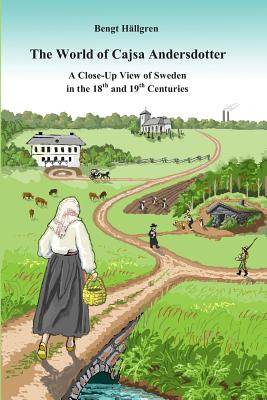The world of Cajsa Andersdotter: A close-up view of Sweden in the 18th and 19th century

The world of Cajsa Andersdotter: A close-up view of Sweden in the 18th and 19th century
The World of Cajsa Andersdotter is a non-fictional book which lets the reader follow the fate of an impoverished Swedish family from about 1760 to 1910. It is primarily based on historical facts from sources such as Church Records, Tax Registers, Land Surveyor Notes, General Muster Rolls, and Estate Inventories, but also, to some extent, on tales handed down within the family. In the 16th century, Sweden had broken away from the Roman Catholic Church to become a Lutheran country. After a successful war against the Catholic countries in central Europe in the early 17th century, the Swedish King and the Church of Sweden cooperated in taking stricter control over the population. Such was the situation at the beginning of this book, which illustrates, with a series of examples, how the decisions of the political and religious leaders befell the simple people on the bottom of society. During the reoccurring wars in the 18th century, soldiers were sent to fight in other countries. Many of them never returned. What happened to their wives and children? The rules of the Church allowed only true Lutherans to share the Holy Communion and to get married. What happened to those who did not pass the compulsory hearings? The difference between social classes was vast. How did a young woman who had grown up in a one-room cottage with a naked earth floor react, when she came to work as a maid in a mansion with parquet flooring and walls covered with French wallpaper? When the last war was over, in 1814, the rural population grew steadily, and ever more provincials sought refuge in the cities. What was life like in the overcrowded, urban, working-class areas? In the late 19th century, democracy and equality gradually developed within the Swedish society. What could an industrious man, starting out with two empty hands, achieve in this situation? The purpose of this book is not only to present the history of Sweden from the perspective of the poor. It also intends to inspire and guide readers who would like to find out more about their own Swedish ancestors. The detailed accounts are based on facts found in historical documents, which next to all are available over the Internet. Over 400 reference notes at the end of the book indicate where to look for information. There is also a supplement discussing the quality and availability of the different sources.
Descrierea produsului
The World of Cajsa Andersdotter is a non-fictional book which lets the reader follow the fate of an impoverished Swedish family from about 1760 to 1910. It is primarily based on historical facts from sources such as Church Records, Tax Registers, Land Surveyor Notes, General Muster Rolls, and Estate Inventories, but also, to some extent, on tales handed down within the family. In the 16th century, Sweden had broken away from the Roman Catholic Church to become a Lutheran country. After a successful war against the Catholic countries in central Europe in the early 17th century, the Swedish King and the Church of Sweden cooperated in taking stricter control over the population. Such was the situation at the beginning of this book, which illustrates, with a series of examples, how the decisions of the political and religious leaders befell the simple people on the bottom of society. During the reoccurring wars in the 18th century, soldiers were sent to fight in other countries. Many of them never returned. What happened to their wives and children? The rules of the Church allowed only true Lutherans to share the Holy Communion and to get married. What happened to those who did not pass the compulsory hearings? The difference between social classes was vast. How did a young woman who had grown up in a one-room cottage with a naked earth floor react, when she came to work as a maid in a mansion with parquet flooring and walls covered with French wallpaper? When the last war was over, in 1814, the rural population grew steadily, and ever more provincials sought refuge in the cities. What was life like in the overcrowded, urban, working-class areas? In the late 19th century, democracy and equality gradually developed within the Swedish society. What could an industrious man, starting out with two empty hands, achieve in this situation? The purpose of this book is not only to present the history of Sweden from the perspective of the poor. It also intends to inspire and guide readers who would like to find out more about their own Swedish ancestors. The detailed accounts are based on facts found in historical documents, which next to all are available over the Internet. Over 400 reference notes at the end of the book indicate where to look for information. There is also a supplement discussing the quality and availability of the different sources.
Detaliile produsului












